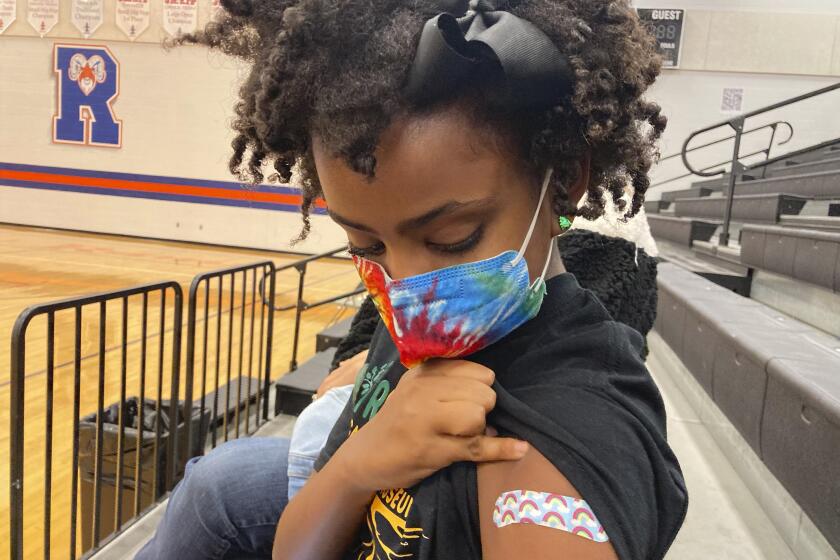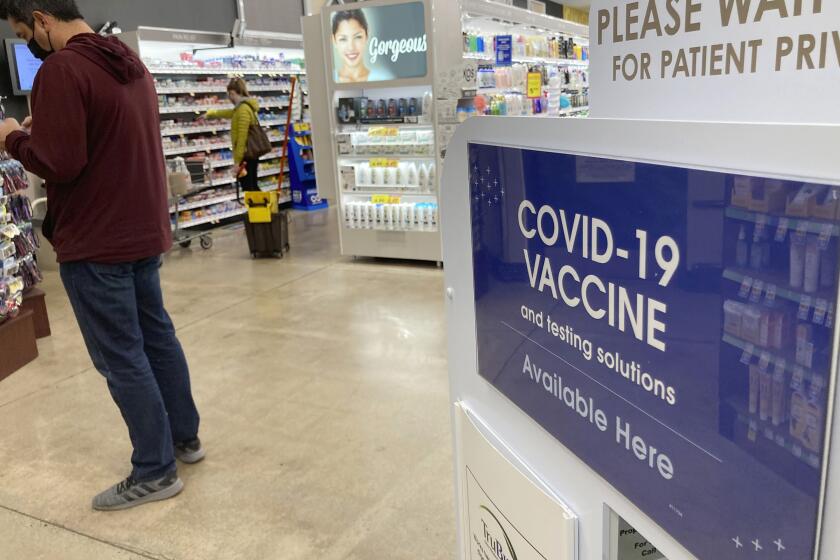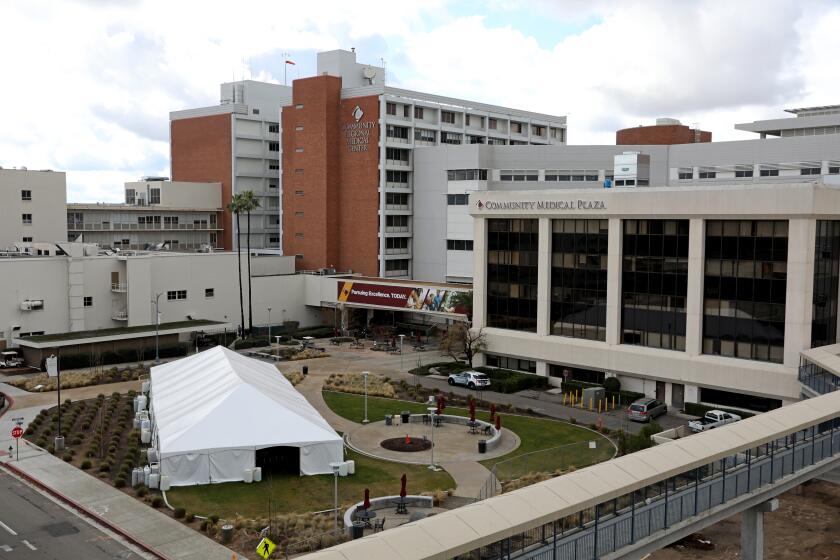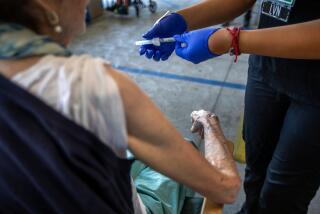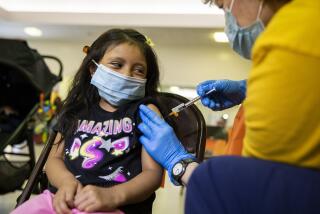California’s coast embraces child COVID-19 shots, but demand lags inland
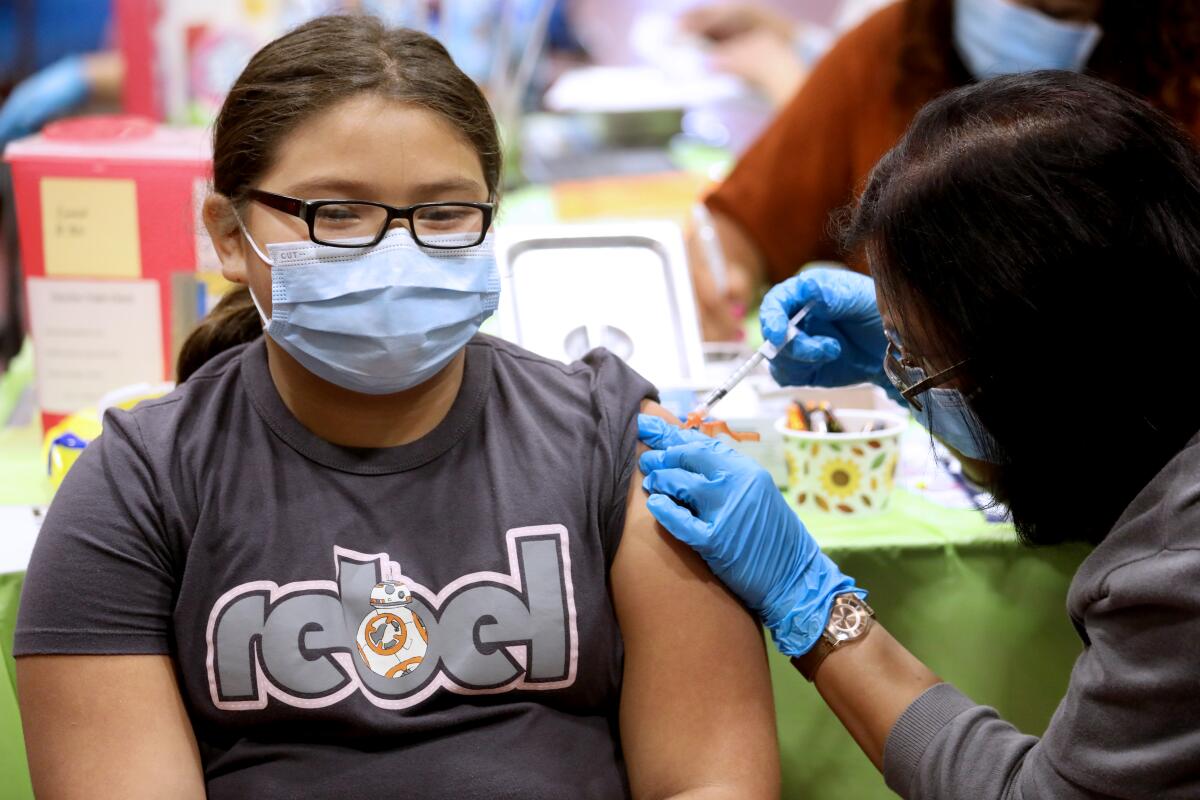
Early demand for the COVID-19 vaccine for young children has been startlingly uneven in California, with some areas embracing the shots and others much slower to accept them, a Times data analysis has found.
It’s a pattern that has experts concerned and could have serious implications for how a coronavirus winter surge could spread through various regions of the state.
In San Francisco, 30% of 5- to 11-year-olds have received one shot since the vaccination was authorized for the age group three weeks ago. In Santa Clara County, home to Silicon Valley, the figure is 28%, and in Marin County, once a hotbed of antivaccination sentiment, it’s an astonishing 46%, according to a Times analysis of state data.
Those rates are well above the national rate of 12% and the statewide rate of 13%. Los Angeles and Orange counties are reporting that 12% of kids in the age group are partially vaccinated; San Diego County reports 13%, and Ventura County, 10%.
Yet uptake of vaccines for kids is lagging across inland California, with rates of 5% in San Bernardino and Kern counties, 6% in Riverside County and 7% in Fresno County.
“In one sense, the higher levels of 5- to 11-year-old vaccination rates is somewhat a surrogate measure for vaccine acceptance at all ages,” said UCLA epidemiologist Dr. Robert Kim-Farley.
Generally, the areas of California with the slowest rate of administering vaccines — rural Northern California and the Central Valley — are where COVID-19 hospitalization rates are the highest.
“There will be a winter surge,” said UC San Francisco epidemiologist Dr. George Rutherford. “What I worry about most is the Central Valley, in more rural California, where vaccination rates are lower than they are in other parts of the state and are currently having high levels of transmission.”
The outlook is most optimistic for the San Francisco Bay Area, which has the state’s highest vaccination rate and lowest COVID-19 hospitalization rate.
“In parts of California with higher vaccination rates, I think we can fully expect the winter surge to be more blunted. We may avoid it; we may not. I suspect it will just be at a lower level,” Rutherford said.
The future for the coastal Southern California counties is less clear. It’s possible that the level of vaccination, plus naturally acquired immunity from last winter’s surge, will leave Southern California’s biggest metro areas “reasonably protected,” Rutherford said.
In a diverse area like L.A. County, there will likely be areas with varying rates of COVID-19 vaccinations, said Dr. Kirsten Bibbins-Domingo, chair of UC San Francisco’s Department of Epidemiology and Biostatistics.
Scientists say vaccinating kids should not only slow coronavirus spread but also help prevent dangerous variants from emerging.
“Ultimately, the experience of vaccination rates is very local. And so how it will play out — it might be some average of the two extremes in the Bay Area and the San Joaquin Valley, but probably more [likely], it will be that some communities will really be much more protected, and some will have the potential to have strikingly higher rates of transmission, especially as we get to the holidays,” Bibbins-Domingo said.
The Inland Empire is already suffering from significantly worse COVID-19 hospitalization rates than coastal Southern California counties. Riverside County has double the COVID-19 hospitalization rate of L.A. County, while San Bernardino County has triple the rate. In San Bernardino, the daily patient count has swelled by about 34% since mid-October.
In San Bernardino and Riverside counties, fewer than 55% of residents of all ages are fully vaccinated, compared with roughly 65% in L.A. and Orange counties and more than 75% in several Bay Area counties.
“They are much worse positioned going into the winter and holiday seasons because of their relatively lower vaccination coverage rates — not only in 5- to 11-year-olds, but in all age groups,” Kim-Farley said.
Infected children can be significant players in the spread of the Delta variant of the coronavirus. Recently, 5- to 11-year-olds have, at times, had the highest coronavirus case rates among all pediatric groups in Los Angeles and Orange counties. Young children are not only at risk of becoming sick themselves but can pass the virus to older relatives, who — even if they are fully vaccinated — would be at higher risk of suffering severe illness should they get a breakthrough infection.
In both states, roughly 63% of all residents are fully vaccinated. But California has one of the best coronavirus case rates in the U.S. and Colorado has one of the worst.
Nationally, new weekly coronavirus cases among children of all ages have increased by about 32% since the beginning of the month, resulting in more than 140,000 children with confirmed infections for the seven-day period that ended Thursday, according to an analysis by the American Academy of Pediatrics and Children’s Hospital Assn. Children now represent 25% of the nation’s reported new cases.
While some people have noted that children are less likely to suffer severe illness from COVID-19 than adults, it remains crucial that they get vaccinated, epidemiologists say. The number of 5- to 11-year-olds who died from COVID-19 in a one-year period — 66 — makes COVID-19 equivalent to the eighth leading cause of death for that age range.
Some physicians also worry about possible long-term consequences of COVID in children, such as higher rates of depression or anxiety, difficulty concentrating in school or long-term headaches. Children also have a rare risk of developing a multisystem inflammatory syndrome related to COVID-19 that can result in serious illness and death.
“Getting children vaccinated is an important part of increasing the overall vaccination coverage and limiting transmission,” Rutherford said. “High vaccination equals low transmission. Low vaccination begets high transmission.”
Officials need to recognize that it’s likely more difficult for people in low-income communities to get access to child COVID-19 vaccines, Bibbins-Domingo said.
Officials are urging California to make it easier to transfer hospital patients to places like L.A. County.
“When you look in the Central Valley, I worry about both active hesitancy as well as, do we have the resources to reach all of the communities in those areas? ... How effective are we at getting vaccines to all the communities where we need to?” she said.
L.A. County officials are concerned that Black and Latino 5- to 11-year-olds and those from lower-income households have been less likely to get vaccinated.
The L.A. County Department of Public Health said Tuesday that white children were three times more likely than Black and Latino children to get vaccinated. While 13% of white, 14% of Asian American and 12% of Native American children in this age group have received a shot, just 4% of Black and 3% of Latino children had done so by Nov. 14.
Children in this age group living in the neediest neighborhoods are being vaccinated at one-third the rate of those in wealthier communities: 3.9% versus 12.5%.
“If we continue to see disparities in pediatric vaccination that put Black and Latinx children at higher risk when transmission increases, we could once again see a situation where these communities suffer the most during a surge,” L.A. County Public Health Director Barbara Ferrer said in a statement Tuesday.
Last week, Ferrer said the disparities in vaccinations demonstrate a need to “build trust in the safety and efficacy of the pediatric vaccine by ensuring that parents have good information, are getting their questions answered and know where to go to get their child vaccinated,” Ferrer said.
Ferrer said L.A. County is working to improve access to vaccines for children in areas where it has been difficult. As of last week, there were more than 700 sites countywide administering doses to 5- to 11-year-olds; hundreds more are expected to begin doing so in the coming weeks.
There’s good reason many experts expect a winter surge to hit California.
Nationally, new daily coronavirus cases have risen by 30% over the past month, from about 72,000 to 94,000; COVID-19 hospitalizations have risen by 15% over the past two weeks.
The U.S. Centers for Disease Control and Prevention considers California as having “substantial” community transmission, the second-worst category in its four-step scale.
California saw both its weekly case rate and hospitalization rate increase in late October; however, in the past two weeks, both numbers have declined.
Still, the state has leveled off at a relatively high rate. The number of daily cases being reported is more than four times higher than in mid-June, when the state reopened its economy and lifted most pandemic-related restrictions on public spaces. COVID-19 hospitalizations are now three times higher than what the state was experiencing at that point.
Warning signs are also apparent in other states, where the coronavirus is once again on the rampage. California’s overall rate of full vaccination is about the same as those of Colorado, Minnesota and New Mexico, which are all experiencing surges and crowding in hospitals.
“Our 63%, while it’s great, isn’t enough,” Rutherford said of California’s vaccination rate.
In Fresno County, hospitals are consistently operating above capacity, and ambulances are being forced to idle outside hospitals before they can unload patients into packed emergency rooms.
“We don’t have enough hospitals to serve the population and the needs,” said Dr. Rais Vohra, the Fresno County interim health officer.
Times staff writers Sean Greene and Thomas Suh Lauder contributed to this report.
More to Read
Sign up for Essential California
The most important California stories and recommendations in your inbox every morning.
You may occasionally receive promotional content from the Los Angeles Times.
